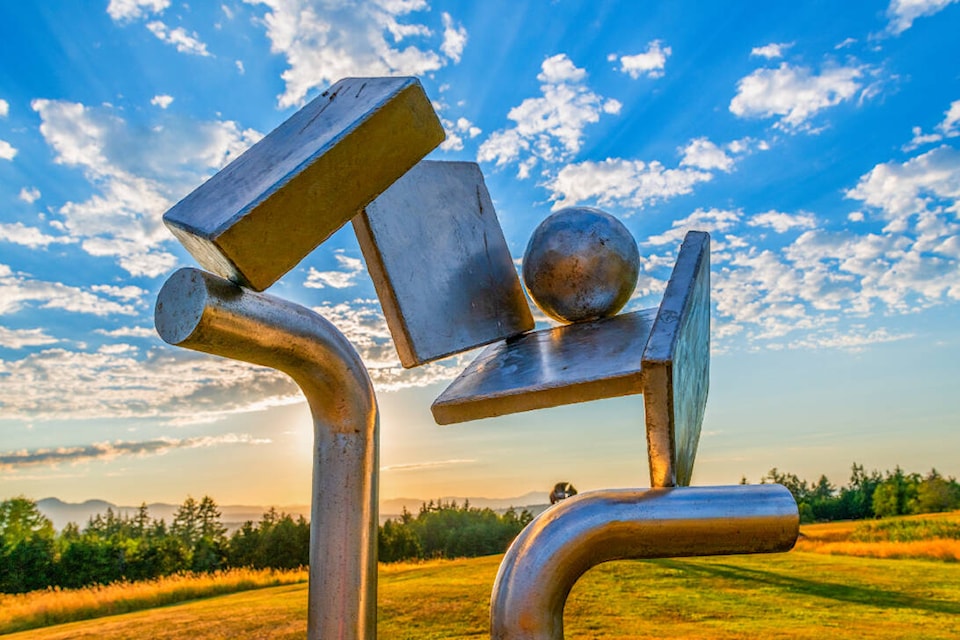Few Vancouver Islanders might know that Hornby Island is home to one of North America’s biggest sculpture parks.
Encompassing more than 200 acres, the Jeffrey Rubinoff Sculpture Park first welcomed the public in back 2008. With no admission fee, visitors are free to roam the land and contemplate more than 100 sculptures crafted by the Canadian sculptor.
From farmer to artist
Dedicated to the work of this enigmatic artist, a rich story lies behind this open-air museum, located at the bucolic foothill of Mount Geoffrey.
Born in London, Ontario, in 1945, Rubinoff spent the first years of his life on the family’s farmstead. Though he genuinely truly enjoyed working the land, the young man’s faith took an interesting turn in his late teens, as explained by Karun Koernig, manager and curator of the park.
“Since he wasn’t the (family’s) first-born son, he wasn’t going to inherit the farm (so) the other kids were expected to go off and have professions.”
Opting for an unorthodox path, the young Rubinoff left the countryside to enrol in one of Ontario’s art schools. Following his graduation, the artist completed a master of fine arts at the University of Oklahoma.
First making his mark as a proficient gesture painter, Rubinioff adopted sculpture later on as his main medium while on the university benches.
“(He learned how to make) sculpture through studio courses. I remember him saying that steel was alive. He had a very passionate and intimate relationship with this material,” explained Koernig, also his long-term friend. “He fell in love with (this) medium that he spent decades on mastering.”
Once out of school, Rubinoff rapidly found a dealer and secured his first solo shows. Soon after, he started touring both his Canada and the U.S.
New homestead on Hornby
In 1973, the sculptor purchased an extensive piece of land on Hornby Island and relocated his workshop to an old barn situated on the property—an antique structure originally built in 1889, making it one of the island’s oldest buildings.
When asked why Rubinoff moved from Central Canada to this small Salish Sea island, Koernig provided a somewhat cryptic response, adding to the enigma surrounding the artist.
“From what he told me, he was looking up and down (B.C.’s) coast for a place where he would be able to work on his large-scale sculptures and that had electricity,” said Koernig. “Why he chose Hornby specifically is a little bit of a mystery, but he did fall in love with this gorgeous west-facing property. Perhaps it was the weather and being able to work a little bit longer in the year.”
Over the next decades, Rubinoff single-handedly transformed the derelict structure into a state-of-the-art steel foundry with cranes, compressors, welding tables, plasma cutters, and an induction furnace.
“He did not have any assistance and he was adamant that he didn’t want to have technical limitations that would restrain his creative ideas,” stated Koernig. “He would insist on controlling both the creative process and the realization. Anything that he did, from the conception, all the way to (the final result), was all done solo.”
In the early 80s, as Rubinoff grew critical of what he called the “commodification of art,” he permanently moved to his insular studio.
For Rubinoff, capitalist interests infiltrated the North American art world, corrupting and stripping it of its core essence.
“(For him, art) became a generator of wealth. Art without that intellectual and emotional stimulation made no sense to him,” said Koernig. “He used to call art a source of knowledge; a nourishment that… builds the internal architecture of the human soul. He thought that art had a bigger mission than charging a couple of bucks (for a sculpture). He wanted to lift people up and give them a place that could make them think.
“He would say that ‘fast food art’ is about killing time; great art is about living time.”
Land transformation begins
In 1996, along with his good friend John Kirk, the artist began reshaping his land to accommodate nearly the entire collection of his life’s work. Over a decade later, in 2008, Rubinoff opened his park to the public.
From monumental sculpture belonging to the modernist art movement to svelte and intricate structures, Rubinoff was adamant that anyone who wanted to visit his permanent exhibition could do it free of charge.
“The sculpture park is supposed to be a statement. It’s a free place to come and we’re not allowed to make any profit,” said Koernig. “He wanted a de-commodified space where… art was the main value on display. He was trying to recreate what he wanted from the New York art world on Hornby.”
In 2017, Rubinoff passed away, leaving in its wake a profound legacy aimed at elevating art to new heights and empowering the next generation of artists through a wide array of scholarships, bursaries, academic awards, and, of course, a park for everyone to visit and wander.
The Jeffrey Rubinoff Sculpture Park is on Hornby Island, two short ferry rides from the Comox Valley, about 2 1/2 hours north of Victoria by car. To learn more about, visit the rubinoffsculpturepark.org.
